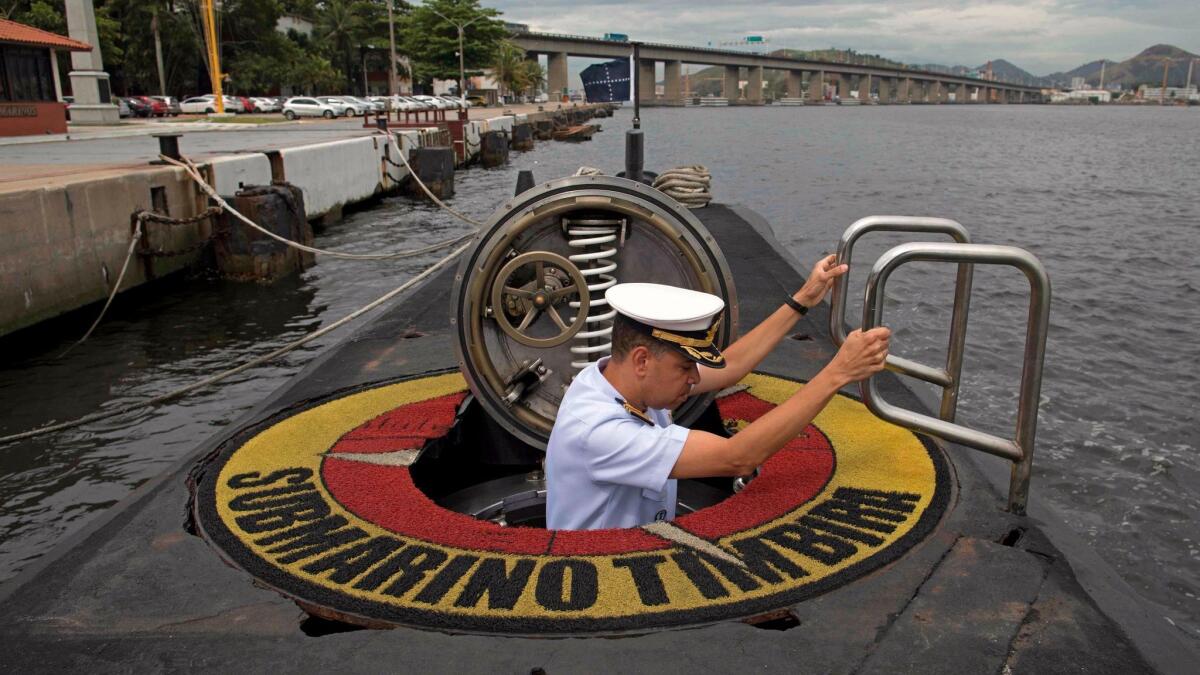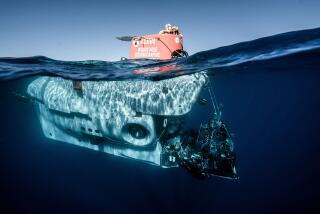What we know and don’t know about Argentina’s missing submarine

Reporting from Mar del Plata, Argentina — A full week after the Argentine submarine’s disappearance, there was no news Wednesday, encouraging or otherwise, about the whereabouts of the San Juan and its 44 crew members. The diesel-electric powered sub disappeared Nov. 15 as it cruised northward from the southern port of Ushuaia toward the naval base at Mar del Plata.
Despite a multinational search and rescue effort involving aircraft, ships and personnel lent by a number of countries, not a trace of the 220-foot sub has been found, nor has a distress signal been received since sub Capt. Pedro Martin Fernandez reported a battery short circuit on Nov. 15, a problem he later said had been repaired.
With the ship’s oxygen supply running low or having run out, family members and Argentine officials are steeling themselves for what may be a tragic outcome.
What is known
Last contact: The last communication between the San Juan and authorities onshore was at 7:30 a.m. on Nov. 15. The submarine surfaced that morning in the area of the San Jorge Gulf, about 270 miles southeast of the Valdes Peninsula in Chubut province. The German-made sub is used to conduct security patrols along the Argentine coastline, and had departed the Ushuaia naval base two days before.
Reports from Argentina’s Defense Ministry on Saturday that it had received seven communication attempts from the crew later turned out to be erroneous.
Power problems: Before losing contact, Fernandez informed onshore authorities that the boat was experiencing battery failure due to a “short circuit,” but later reported that the problem had been fixed. The ship is powered by a mixture of diesel and electric power stored in 960 batteries. Fernandez was then ordered to change course and take as direct a route as possible to Mar del Plata naval base, about 520 miles to the north.
Oxygen system: Barring an explosion or devastating fire, the key to the crew’s survival is the onboard oxygen system. Unless the sub has been able to surface to replenish the supply since it lost contact on Nov. 15, the vessel’s oxygen supply is good for seven or eight days maximum, officials say. And since Wednesday marked the seventh day since losing contact, the San Juan can now be said to have entered a “critical stage” of survivability if it has been unable to surface.
Multinational search and rescue effort: The U.S., Britain, Brazil, France, Peru, Chile, Colombia, Germany and Uruguay have joined Argentina to deploy 17 aircraft and 15 vessels in a frantic search effort in the South Atlantic covering 187,000 square miles. The operation based in the southern city of Comodoro Rivadavia includes more than 4,000 military personnel from various countries.
The U.S. Navy has provided a P-8 Poseidon aircraft and NASA has lent a research aircraft that is capable of detecting submarines below or above the ocean surface. The Navy has also sent a manned rescue chamber capable of submerging to depths of 850 feet as well as unmanned underwater vehicles such as the Bluefin 12D that can search huge expanses of ocean floor using sonar technology.
On Wednesday, Russia offered help as well. In 2000, the Russian submarine Kursk was lost in the Barents Sea and all 118 crew members on board died.
What isn’t known
Whereabouts of the submarine: Argentine authorities have received no signals from the sub since it disappeared. The frantic search and rescue operation in the South Atlantic co-directed by the Argentina and U.S. navies thus far has turned up no traces of the vessel.
Cause of the disappearance: Although the sub captain reported the battery failure, he later said the malfunction had been fixed, leaving authorities to wonder whether something else could have gone wrong such as a fire or collision. Battery problems could have occurred again possibly because of leaks when the sub raised its “snorkel” as part of its surfacing procedure.
Names of the crew: The Argentine Defense Ministry still has not officially released the names of the 43 men and one woman on the crew, although news reports and interviews with family members have made most of them known.
Why the delay in disclosing battery problem: Authorities waited five days to reveal that Fernandez had reported the battery failure. One spokesman said later that it didn’t occur to the military to announce it because the commander subsequently reported the problem as having been fixed, but critics have questioned the motive for the delay.
The submarine, which was built in the early ’80s, was given an overhaul starting in 2008 that extended its useful life by 30 years, authorities say. But they have so far refused to disclose whether the vessel had experienced any mechanical issues since then.
Why no distress signals: As baffling as the sub’s disappearance is, its apparent failure to use any of a number of distress signals or mechanisms at its disposal is troubling. For starters, the boat’s commanders could have released an emergency buoy that would have positioned the sub for searchers with radio SOS signals.
The San Juan also is equipped with an ejectable cylinder that releases green fluid a half mile in diameter once it reaches the surface. Moreover, the vessel has large life rafts that can be released if an abandonment is expected.
Officials have theorized that either searchers have yet to come across any of these distress signals or that the submarine was quickly and devastatingly incapacitated by a cataclysmic event onboard.
Special correspondents D’Alessandro and Kraul reported from Mar del Plata, Argentina, and Bogota, Colombia, respectively.
More to Read
Sign up for Essential California
The most important California stories and recommendations in your inbox every morning.
You may occasionally receive promotional content from the Los Angeles Times.










